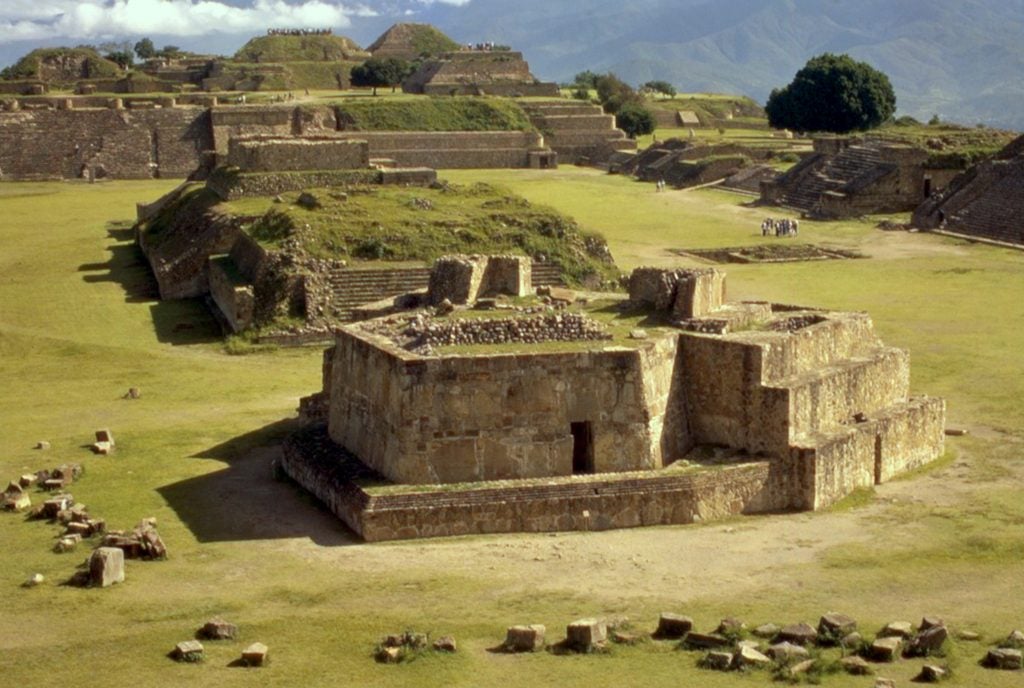The Zapotec state centered at Monte Albán in Oaxaca was one of Mexico’s earliest. Our perspective on this early state comes from the results of four different projects: (1) Flannery and Marcus’ excavations at San José Mogote; (2) a settlement pattern survey of the entire Valley of Oaxaca (including Monte Albán) by Richard Blanton, Stephen Kowalewski, Gary Feinman, Linda Nicholas, and Laura Finsten; (3) the excavation of San Martín Tilcajete by Charles Spencer and Elsa Redmond; and (4) survey and excavation in the Cuicatlán region by Spencer and Redmond.
Many first-generation states arose in the context of competing chiefly societies, when one of those societies gained an advantage that allowed it to defeat its rivals and incorporate them into a larger polity. Something similar happened in the Valley of Oaxaca, where the Rosario phase witnessed competition among at least three chiefly societies (see the section on The Origins of Social Inequality). The steps involved in the origins of the Zapotec state were as follows:
- At the end of the Rosario phase, roughly 2000 people (1000 from San José Mogote itself and another 1000 from its satellite villages) left the northern Valley of Oaxaca and colonized the summit of the 400-meter-tall mountain known today as Monte Albán. They began construction of a 3-kilometer-long defensive wall on the more easily climbed slopes of the mountain, then set about subduing their rivals. As their conquests proceeded, they erected a public building featuring hundreds of carved images of slain or sacrificed captives.
- During Early Period I of Monte Albán (500-300 BC in conventional radiocarbon years) Monte Albán’s population grew from 2000 to 5000.
- In response to the threat from Monte Albán, its rival to the south—-San Martín Tilcajete—-doubled its size. It also chose a different orientation for its public buildings, 25 degrees E. of North rather than Monte Albán’s true north-south.
- At roughly 300 BC Tilcajete was attacked and its public buildings burned, presumably by Monte Albán. Tilcajete refused to capitulate, however; instead it increased its size further, moved its buildings upslope, and added defensive walls.
- Temporarily unable to subdue its in-valley rivals, Monte Albán sent warriors into the Cuicatlán area to conquer a less-well-organized polity. It then used the conquered area as a source of tropical fruits.
- During the Late Monte Albán I period (300 BC-AD 1 in conventional radiocarbon years), Monte Albán surrounded itself with a ring of 155 satellite villages. Most of these were in settings where canal irrigation could be practiced, providing Monte Albán with thousands of farmers, warriors, and craftsmen.
- Thus fortified and with its urban population doubled, Monte Albán attacked and burned Tilcajete again at roughly 30 BC. This time Tilcajete collapsed and was abandoned. Among the burned buildings were a large 8-room palace and a 2-room temple. Both these buildings were characteristic of the ancient Zapotec state. The implications are that during Late Monte Albán I, both Monte Albán and Tilcajete had been developing the institutions typical of kingdoms.
- Once having vanquished its powerful in-valley rivals, Monte Albán emerged as the political capital of the 2100 km2 Valley of Oaxaca, and continued to expand into neighboring regions wherever possible. It was not able to expand north of Cuicatlán, however, because there its interests came into conflict with those of Teotihuacan, a rival expansionist state. Eventually Monte Albán and Teotihuacan achieved a kind of détente, leaving each other alone while subduing weaker neighbors.

Copyright © 2021 University of Michigan Museum of Anthropological Archaeology (UMMAA)

